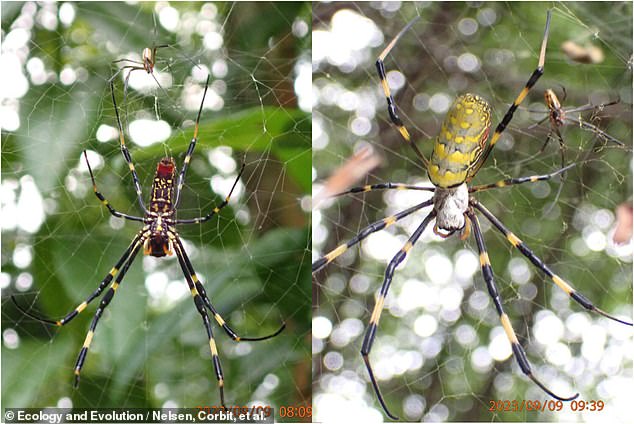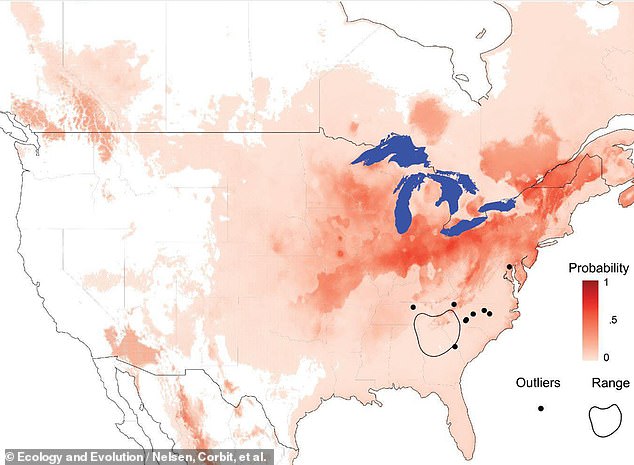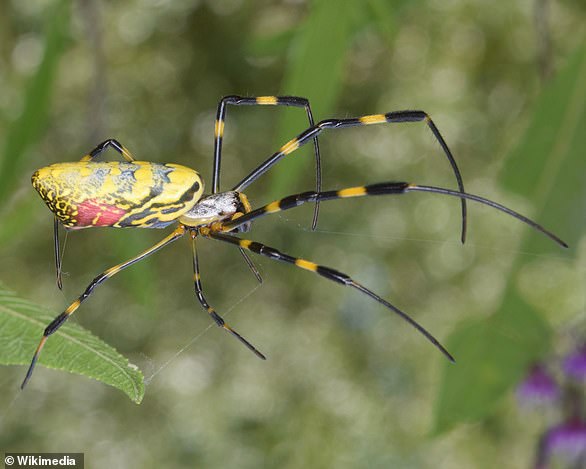Giant 8in spiders from China are set to invade the US: Black and yellow critters seen parachuting through the air on the east coast – and will soon hit New York and New Jersey
An 8-inch-long venomous spider native to Asia, whose palm-sized females eat cannibals, is flying up America's East Coast and even spreading west.
Experts say the Guru spider can fly 50 to 100 miles, using its webbing as a parachute to glide in the wind, and is now riding East Coast highways — but the creatures are not yet known to pose a threat to animals. Humans or pets.
However, the jury is still out on the impact this gentle giant spider, which is believed to have first arrived in the United States a decade ago via shipping containers arriving in Georgia, will have on local wildlife.
One thing is certain, according to an ecologist at Rutgers University's Lockwood Laboratory in New Jersey, who spoke to DailyMail.com: “Soon enough, maybe even next year, they should be in New Jersey and New York.”
An 8-inch-long venomous spider native to Asia, whose palm-sized females eat their male companions, flies up America's East Coast and spreads as far west as

Experts say the Guru spider can fly 50 to 100 miles, using its webbing as a parachute to glide in the wind, and can ride horses on East Coast highways. One environmental scientist says it will be in New York and New Jersey “soon enough, maybe even next year.”
PhD student and ecologist José R Ramírez Garofalo told DailyMail.com: 'Since the main ways of spreading are either 'ballooning' into the wind, or riding in cars, they will generally spread to where the wind is blowing. Strikes, or where humans.
Ramirez Garofalo, who is currently conducting research for Rutgers University Lockwood LaboratoryWhile it's likely the Guru spider will be able to take advantage of the warm temperatures along the northeast coast, hiking and skydiving routes will certainly take it further than some other invasive species, he added.
'T“Expanding a legacy range is more complex than the typical northward expansion you see with a lot of species under current climate conditions,” Ramirez Garofalo told DailyMail.com.
“Right now, we're seeing them spreading into Maryland,” the ecologist said recently Staten Island Progress. “It's a matter of when, not if.”
Last month, other ecology and entomology researchers from New York, Tennessee, Texas and South Carolina pooled their resources in an attempt to predict how quickly and how far the invasive Guru spider will spread. It was likely to spread.
The short answer is that it is widespread throughout the continental United States, Canada, and even parts of Mexico.
Their findings were published in the journal Environment and evolution“,” Add evidence of this T clavata (short form of the species name Jorō, Trichophyton clavata) is an invasive species and deserves more environmental scrutiny
'While traces T clavata They continued: “It has not been documented on human or pet health, and our data show that its environmental impacts may not be similarly benign as its invasion progresses.”
The researchers hope their estimates — based on captured spiders and climate comparisons between North American regions and Guru habitats in Japan, China, Korea and Taiwan — will spur action to protect native spider species.
“These patterns should strongly motivate funding institutions and researchers alike to turn their attention toward this invasion and consider ways to mitigate its impacts on indigenous communities,” they wrote.

Last month, other ecology and entomology researchers from New York, Tennessee, Texas and South Carolina pooled their resources in an attempt to predict how quickly and how far the invasive Guru spider might spread. The short answer is far and wide throughout the United States

The researchers hope their estimates – based on captured spiders and climate comparisons with regions of North America and the natural habitats of Juru in Japan, China, Korea and Taiwan – will spur action to protect native spider species.
While guru poison experts say they pose no threat to humans or dogs and cats, they will only bite if they feel severely threatened.
If spiders do bite, it will feel like an accidental pinch because spiders' fangs are not large and sharp enough to pierce human skin, according to Paula Cushing, an arachnologist at the Denver Museum of Nature and Science, who allowed one to go into her palm.
In contrast, the Guru spider feeds mostly on flies, mosquitoes, and stink bugs, the latter of which not only pose a threat to crops but are currently devoid of natural predators in parts of the United States.
Researchers say the Guru River could be a blessing in disguise for farmers and should be left alone.
“There's no real reason to crush them effectively,” said Benjamin Frick, a researcher at the University of Georgia. “Humans are the root cause of their invasion.” Don't blame Spider Guru.
More than 150 years ago, a cousin of the Guru spider, called the golden silk spider, also made its way to the United States from South America and the Caribbean.
However, unlike Jorō, these spiders do not have the same physical traits that allow them to spread in different climates across the country as they mainly live in the southeastern United States.
The life cycle of guru spiders usually ends in late fall or early winter. Then the next generation appears in the spring.
(Tags for translation)dailymail

